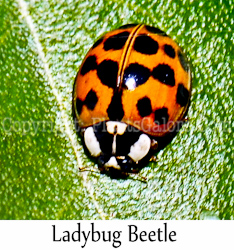 We
hear a lot about the "good guys" in the garden but this
is a "good gal" that often gets overlooked. Ladybug or
sometimes, ladybird, beetles are one of those
beneficial insects
that we need to foster in our gardens.
We
hear a lot about the "good guys" in the garden but this
is a "good gal" that often gets overlooked. Ladybug or
sometimes, ladybird, beetles are one of those
beneficial insects
that we need to foster in our gardens.
Both as attractive adults
and as their ugly larvae, ladybug beetles do a fine job
of feeding on aphids that are attacking our plants.
There are several hundred different species of ladybugs
in varying sizes and color combinations.
Ladybugs are commercially
available and may be purchased to be delivered to your
house in the mail. It sounds like such a great idea to
have your garden filled with these voracious defenders.
Unfortunately, it does not always work out the way we
plan.
You have to remember
that, even though you bought and paid for these beetles,
they owe you no allegiance what so ever. Their only
goals in life are to eat aphids and reproduce. So, in
order to keep them in your garden, you have to have a
crop of aphids growing on your plants. Once the aphids
are gone...so are the ladybug beetles. Since they have
wings, they simply fly away in search of more prey.
As with all beneficial
insects, they will thrive and increase in numbers only
when their prey is also thriving. When the prey
declines, so will the predators, i.e. ladybugs. Also, to
make this strategy work, you need to avoid or, at least
be very careful, with the use of non-selective
pesticides which can kill the beneficials as well as the
bad guys.



